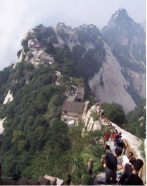Hazy with a chance of sunshine
Air pollution may reduce rainfall.
By Emily Sohn
We hear a lot these days about how air pollution is changing temperatures on Earth. New evidence from a mountaintop in China now suggests that pollution can also change the amount of rain and snow that fall in some places.
 |
|
Hazy conditions atop China’s Mount Hua may reduce rainfall and snowfall there as much as 30 percent.
|
| Science |
Usually, more precipitation falls in mountainous places than in flat areas upwind from the mountains. That’s because air can hold a lot of water. When wind blows wet air up a mountainside, the air gets colder. This temperature change often forces water to fall out of the air as rain or snow.
In recent years, however, many mountainous areas in the western United States have been getting 25 percent less precipitation than normal. Mountains that are downwind of cities have experienced the biggest drops.
Some scientists have theorized that pollution drifts from the cities into the mountains, affecting rainfall. But proving this link has been difficult.
In the quest for answers, a team led by a scientist from the Hebrew University of Jerusalem turned to a mountain in China called Mount Hua. The mountain is 2,060 meters (6,760 feet) tall and lies about 120 kilometers (75 miles) east of the Chinese city of Xi’an. Since 1954, meteorologists have been collecting details about rainfall, humidity, and visibility in the area.
Using these data, the scientists compared rainfall on Mount Hua with rainfall in the nearest city, Huayin, on days with varying levels of visibility. When the air was clear and people could see as far as 20 km (12.4 miles) away, the scientists found that 65 percent more rain fell on the mountain than in the city.
But when the air was smoggy, allowing only 8 km (5 miles) of visibility through the haze, the mountain received just 20 percent more rain than the city did. The new data support the theory that pollution stifles rainfall.
Some scientists believe that there are other explanations for the numbers. It’s possible, for example, that naturally occurring particles in the air, rather than particles produced by pollution, are affecting visibility.
This is the first study to look at the connection between rainfall and changes in visibility due to air pollution. Future studies are needed to verify the link.
Going Deeper:
Perkins, Sid. 2007. High and dry: Pollution may stifle mountain precipitation. Science News 171(March 10):149. Available at http://www.sciencenews.org/articles/20070310/fob6.asp .
Sohn, Emily. 2004. A dire shortage of water. Science News for Kids (Aug. 25). Available at http://www.sciencenewsforkids.org/articles/20040825/Feature1.asp .







